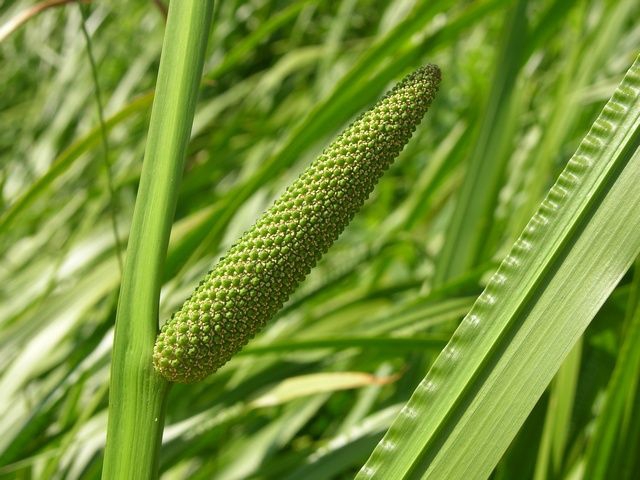| Citation |
|
Description |
Geographic Range [top]
Range Description: Sweet flag is native throughout most of Russia east through Kazakhstan, India and Mongolia to China, Japan, the Korean Peninsula and the eastern seaboard of Russia, south through South-east Asia to Sulawesi. It occurs as a non-native throughout the Caucasus, Pakistan and Europe where it has been established in some areas since the early 1800s. It is considered native to much of North America but introduced to the west and south-east of the USA (The Board of Trustees of the Royal Botanic Garden, Kew 2013).
Countries occurrence:
Native:
Bangladesh; Belarus; Cambodia; Canada (Alberta, British Columbia, Manitoba, New Brunswick, Newfoundland I - Regionally Extinct, Northwest Territories, Nova Scotia, Ontario, Prince Edward I., Québec, Saskatchewan); China (Guangdong, Guangxi, Guizhou, Xinjiang, Yunnan); Georgia; Hong Kong; India; Indonesia (Jawa, Lesser Sunda Is., Sulawesi); Japan; Kazakhstan; Korea, Democratic Peoples Republic of; Korea, Republic of; Lao Peoples Democratic Republic; Malaysia (Peninsular Malaysia, Sarawak); Mongolia; Myanmar; Nepal; Philippines; Russian Federation (Altay, Amur, Buryatiya, Chita, Irkutsk, Krasnoyarsk, Kuril Is., Primoryi, Sakhalin, Tuva, West Siberia); Sri Lanka; Thailand; Turkey (Turkey-in-Europe); United States (Alabama - Introduced, Alaska, Arkansas - Introduced, California - Introduced, Colorado - Introduced, Connecticut, Delaware - Introduced, District of Columbia - Regionally Extinct, Georgia, Georgia - Introduced, Idaho, Illinois - Regionally Extinct, Indiana - Regionally Extinct, Iowa, Kansas, Kentucky - Introduced, Louisiana - Introduced, Maine, Maryland - Introduced, Massachusetts, Michigan, Minnesota, Mississippi - Introduced, Missouri - Introduced, Montana, Nebraska, New Hampshire, New Jersey - Regionally Extinct, New York, North Carolina - Introduced, North Dakota - Regionally Extinct, Ohio, Oklahoma - Introduced, Oregon - Introduced, Pennsylvania, Rhode Island - Introduced, South Carolina, South Dakota, Tennessee - Introduced, Texas - Introduced, Vermont, Virginia - Regionally Extinct, Washington, West Virginia - Introduced, Wisconsin); Uzbekistan; Viet Nam
Introduced:
Albania; Austria; Belgium; Bosnia and Herzegovina; Bulgaria; Croatia; Czech Republic; Denmark; Faroe Islands; Finland; France (France (mainland)); Germany; Greece (Greece (mainland), Kriti); Guernsey; Hungary; Iceland; Ireland; Italy (Italy (mainland), Sicilia); Jersey; Netherlands; Norway; Papua New Guinea (Papua New Guinea (main island group)); Poland; Svalbard and Jan Mayen; Sweden; Switzerland; United Kingdom (Great Britain, Northern Ireland)
Upper elevation limit (metres): 2800
Range Map: Click here to open the map viewer and explore range.
Population [top]
Population: Sweet flag is widespread and abundant throughout its native and non-native range in the Old World. It is widespread and abundant in parts of North America, and occurs non-native over a wide area. However, there have been local extinctions on the eastern seaboard (The Board of Trustees of the Royal Botanic Gardens, Kew 2013).
Current Population Trend: Increasing
Additional data:
?Population severely fragmented: No
Habitat and Ecology [top]
Habitat and Ecology: The species grows on the margins of standing or slow-flowing water, typically in river backwaters, canal margins and the margins of ponds and lakes.
Systems: Terrestrial; Freshwater
Continuing decline in area, extent and/or quality of habitat: Unknown
Use and Trade [top]
Use and Trade: The species root have a long history of medical usage. It is known as an old folk remedy for the treatment of arthritis, neuralgia, diarrhea, dyspepsia, hair loss and other disorders. The dried rhizomes of the plant constitute the drug calamus and are used in medicines. It is used medicinally for a wide variety of ailments including head and stomach aches, aromatic stimulant, mild tonic, etc.
It is tolerant of pollution and has been used to purify sewage.
Threats [top]
Major Threat(s): No information is available on threats to the species or its habitats.
Conservation Actions [top]
Conservation Actions: No conservation measures have been undertaken specifically for this species and none are needed.
Citation: Lansdown, R.V. 2014. Acorus calamus. The IUCN Red List of Threatened Species 2014: e.T168639A43116307. . Downloaded on 08 December 2015.
Disclaimer: To make use of this information, please check the .
Feedback: If you see any errors or have any questions or suggestions on what is shown on this page, please provide us with feedback so that we can correct or extend the information provided |

